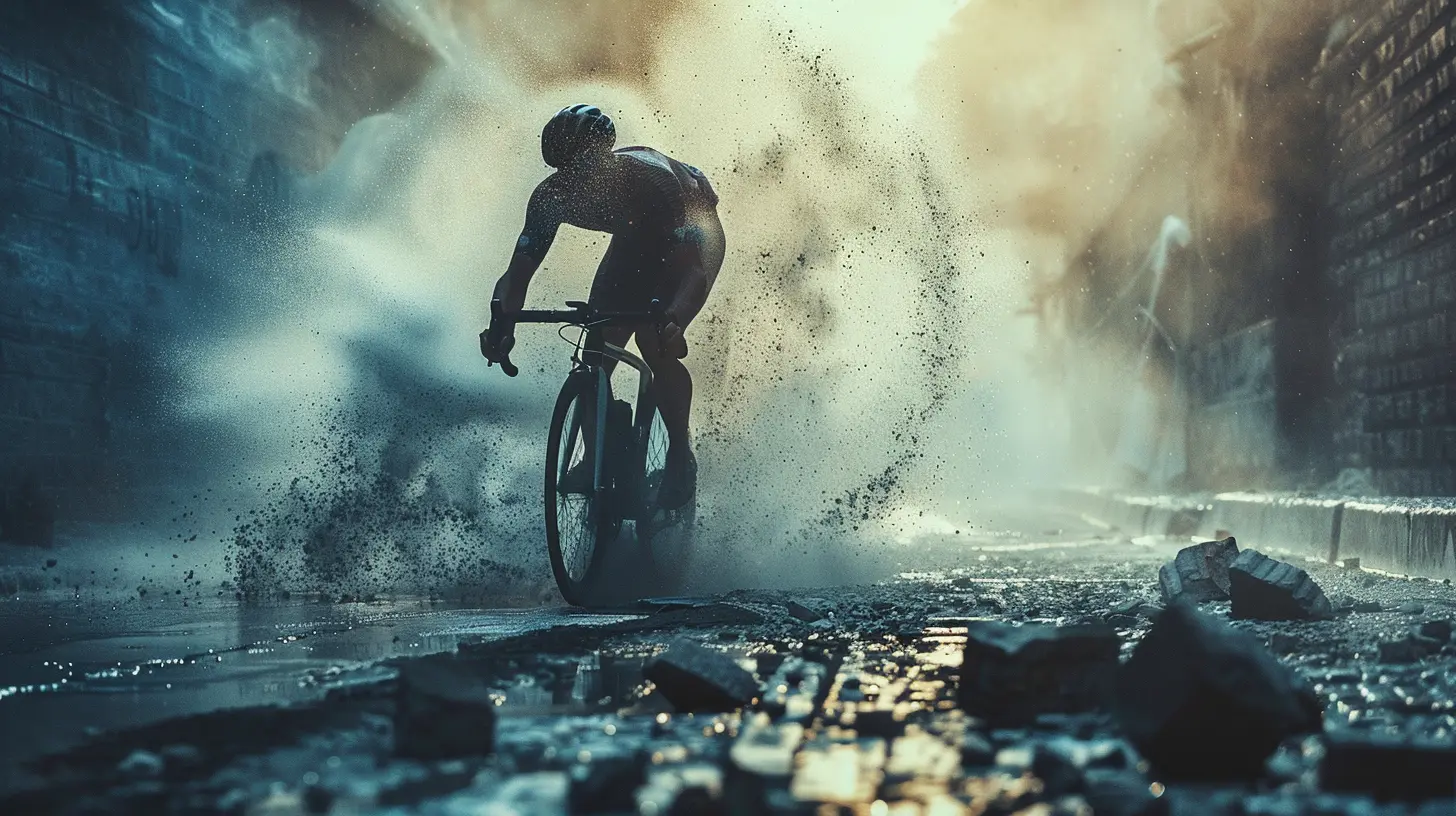Running Off the Bike: Mastering the Triathlon Brick Workout
15 June 2025
Have you ever hopped off a long bike ride, tried to run, and felt like your legs instantly turned to jelly? Welcome to the surreal world of the triathlon brick workout—where your mind is game, but your legs are screaming, “What are we doing!?”
In triathlon, it's not just swim, bike, run—it's transition, adaptation, a mental and physical rollercoaster that demands finesse. And right at the heart of it is the bear we call running off the bike. This isn't just a test of endurance—it's choreography, it's rhythm, it’s art.
So, buckle in. Let’s unravel the mystery of the all-important brick.
What Is a Brick Workout Anyway?
Let’s demystify it. A brick workout is when you combine two disciplines of triathlon in a single session, most commonly biking immediately followed by running. Why the name “brick”? Some say it refers to how your legs feel—as heavy as bricks. Others say it comes from stacking workouts like bricks. Either way, it sticks.You might think, "What's the big deal? I know how to bike. I know how to run." But combining them? That’s a whole different animal. That’s where the magic—and the madness—happens.
Why Is Running After the Bike So Hard?
Let’s be real: it sucks. At first.Your body is smart. It gets comfy in a rhythm. After 40K on the bike, your legs are like, "Oh cool, we're bikers now." Then suddenly, you slam the brakes, rack your bike, and switch gears—literally and figuratively—to run.
Your muscles are confused. Your blood flow shifts. Your cadence is off. Your mind is saying “go,” but your legs feel like mashed potatoes. That’s neuromuscular disorientation, and it’s the villain in this saga.
But the good news? Like any villain, it can be defeated—with consistency, patience, and a few good bricks.
Benefits of Brick Workouts
You might be wondering—why put yourself through this discomfort regularly?Because brick workouts are the secret weapon. They train your body and mind to handle the transition. They:
- Adapt your legs to the reality of running post-bike.
- Improve efficiency in transitions (T2).
- Build mental toughness like no other workout.
- Boost endurance, especially for race-specific fatigue.
In short, if you want to be race-ready, these sessions are non-negotiable.
How Often Should You Do Brick Workouts?
Here’s where personalization kicks in.For beginners, once a week is enough. For intermediate and advanced athletes, twice is solid—depending on your training cycle. Quality over quantity is the golden rule.
But don’t overdo it. Your legs need recovery. Brick workouts are intense—not just physically, but neurologically. Don’t stack too many back-to-back high-intensity bricks unless you’ve got a seasoned base.
Types of Brick Workouts You Can Try
Let’s get into the meat and potatoes. Not all brick workouts are created equal. Here are a few tasty options you can slot into your training week.1. Classic Bike-Run Brick
- Ride 60-90 minutes at race pace.- Immediately run 15-30 minutes at moderate pace.
This is the go-to session for building basic adaptation. It simulates race conditions and hones transition smoothness.
2. Short and Fast Bricks
- Ride 30 minutes at tempo.- Run 10-15 minutes at 5K pace.
Great for speed and turnover. These teach your legs how to move fast even when tired.
3. Big Day Simulation Brick
- Long ride (2-4 hours at endurance pace).- Transition into a 30-60 minute run.
These mimic race fatigue and are key for long-course triathletes.
4. Multi-Brick Sets (Duathlon Style)
- Bike 20 min, Run 10 min.- Repeat 2-3 times.
Perfect for practicing transitions, mental refocus, and running rhythm changes.
Mix it up. Keep your body guessing. The variety also helps keep your motivation high—it’s a grind, but it doesn’t have to be boring.
How to Nail the Transition (T2 Like a Pro)
Let’s talk transitions—where races can be won or lost.A seamless transition from bike to run is more than tossing your bike and dashing off. Here’s how to smooth the ride:
- Practice your gear layout. Know where your shoes are. Make it muscle memory.
- Elastic laces can save precious seconds and reduce stress mid-race.
- Visualize the transition. Mental repetition helps when the adrenaline spikes.
- Keep it simple. Don’t overcomplicate. Efficiency is elegance.
And yes, doing brick workouts regularly is the best way to get better at this. You can’t fake familiarity.
Tips for Mastering the Run Off the Bike
Here’s where things get poetic—where your heart pumps courage and your legs follow, however reluctantly.1. Start Slow—Then Settle
Don’t sprint out of T2. Your heart rate is already elevated from the ride. Start controlled. Let your body catch up. Settle into your rhythm over the first mile.2. Focus on Form
Your posture after cycling is often hunched. Open your chest. Lift your knees. Drive your arms. Think tall and light like you're chasing the horizon.3. Cadence is King
Short, quick strides help recondition your legs. Count your steps. Aim for a steady, efficient cadence.4. Fuel and Hydrate
What you put into your body on the bike impacts your run. Nail your nutrition. Test during training. Don’t improvise on race day.5. Train the Mind
Your body will scream. Let it. Focus on breath. Break the run into mental chunks. Visualize mile markers. You’re not just running—you’re negotiating with your limits.Mistakes to Avoid in Brick Workouts
Even seasoned athletes fall into these traps:- Skipping the transition practice altogether.
- Going full-gas every brick session—burnout alert!
- Ignoring recovery—bricks take more toll than you think.
- Not hydrating properly before the run.
- Treating it like a routine jog instead of a focused session.
Avoid these, and watch your confidence skyrocket.
How to Recover from a Brick Workout
You survived the furnace—now tend to the coals. Recovery matters.- Cool down with light spinning or walking.
- Stretch your hip flexors, quads, calves—show them some love.
- Rehydrate and refuel—think carbs + protein combo.
- Rest smart—sleep is your superpower. Prioritize it.
Respecting the recovery process is what sets sustainable athletes apart from burnt-out heroes.
The Mental Side: Pushing Through the Brick Wall
Make no mistake—brick workouts sharpen not just your muscles, but your mind.Running off the bike is a lesson in recalibration. Every brick teaches your mind to override doubt. You practice resilience, grit, and adaptability.
It's not about ignoring the pain. It’s about learning to dance with it. To move gracefully through discomfort. To hear the inner voice say “Keep going,” louder than the one whispering “Stop.”
The more bricks you build, the stronger your mental foundation becomes.
Final Thoughts: Embrace the Bricks, Embrace the Burn
There’s a certain romance to the struggle. The way your legs rebel, the way your breath stutters, the way you find rhythm in chaos.Brick workouts aren’t glamorous. They don’t always feel good. But they’re the soul of triathlon training. They’re where athletes are forged, tested, and transformed.
So lace up. Clip in. Run when you don’t want to. Train your transitions like they're your superpower. Because on race day, when others falter, you'll be the one flying—not stumbling—off the bike.
Welcome to the beautiful, brutal, brilliant world of bricks.
all images in this post were generated using AI tools
Category:
TriathlonAuthor:

Uziel Franco
Discussion
rate this article
2 comments
Madison Roth
Great insights on the importance of brick workouts for triathletes! Incorporating these sessions boosts efficiency and prepares your body for the unique transition from cycling to running. Remember to start slow and focus on maintaining form. Happy training! 🏃♂️🚴♀️
June 21, 2025 at 4:58 AM

Uziel Franco
Thank you! I'm glad you found the insights helpful. Happy training and best of luck with your brick workouts! 🏃♂️🚴♀️
Icarus Luna
Embrace the challenge of brick workouts! Each run off the bike builds strength and resilience, bringing you closer to your triathlon goals. Keep pushing your limits, and remember, every step counts towards your success!
June 16, 2025 at 3:32 AM

Uziel Franco
Thank you! Embracing brick workouts truly enhances strength and endurance, making each run invaluable for triathlon success!
![Breaking Records and Barriers: [Player Name]s Historic Season](/pictures/blog/small/breaking-records-and-barriers-player-names-historic-season_1.webp)

![The Engine of the Team: How [Player Name] Drives Success](/pictures/blog/small/the-engine-of-the-team-how-player-name-drives-success_1.webp)